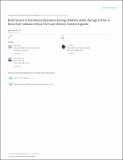| dc.contributor.author | Peter Kirabira1*, David Omondi Okeyo2 , and John C. Ssempebwa | |
| dc.date.accessioned | 2022-01-30T11:13:26Z | |
| dc.date.available | 2022-01-30T11:13:26Z | |
| dc.date.issued | 2018 | |
| dc.identifier.uri | https://repository.maseno.ac.ke/handle/123456789/4783 | |
| dc.description.abstract | Introduction: Dysentery, otherwise called bloody diarrhoea, is a problem of Public Health importance globally,
contributing 54% of the cases of childhood diarrhoeal diseases in Kumi district, Uganda. We set out to assess the
risk factors associated with the persistently high prevalence of childhood dysentery in Kumi district.
Methods: We conducted an analytical matched case-control study, with the under five child as the study unit.
We collected quantitative data from the mothers or caretakers of the under five children using semi-structured
questionnaires and checklists and qualitative data using Key informer interview guides. Quantitative data was
analysed using SPSS while qualitative data was analysed manually.
Results: Under fives living in a household of more than 5 people had a 19.2 times higher risk of developing
dysentery (OR 19.2, CI 4.4–90.1), and children from households with boiled their drinking water were less than
1% less likely to develop dysentery (OR <0.001, CI 0.1–0.5). There was neither difference between households
that used piped water and the development of dysentery (OR 1.1, CI 0.1–8.2), nor households which had another
child that had ever had dysentery in the household and having dysentery (OR 3.2, CI 0.3–40.4). Major dysentery
risk factors were over-crowding and big family sizes but these were still un-known to the majority of the people, yet
people tended to avoid safe water sources like piped water and protected wells or springs due to long distances,
high piped water connecting costs and high water bills.
Conclusion: Whereas most mothers were knowledgeable of the causes and prevention of dysentery, they did not
actually practice what they knew. Sustained campaigns on dysentery prevention and control by the government and
other stakeholders are needed. | en_US |
| dc.publisher | Research gate | en_US |
| dc.subject | Childhood dysentery, Knowledge/Awareness, Water source, Kumi town council, Case-control studies, Mothers/Caretakers. | en_US |
| dc.title | Risk Factors to Persistent Dysentery among Children under the Age of Five in Rural Sub-Saharan Africa; the Case of Kumi, Eastern Uganda | en_US |
| dc.type | Article | en_US |

